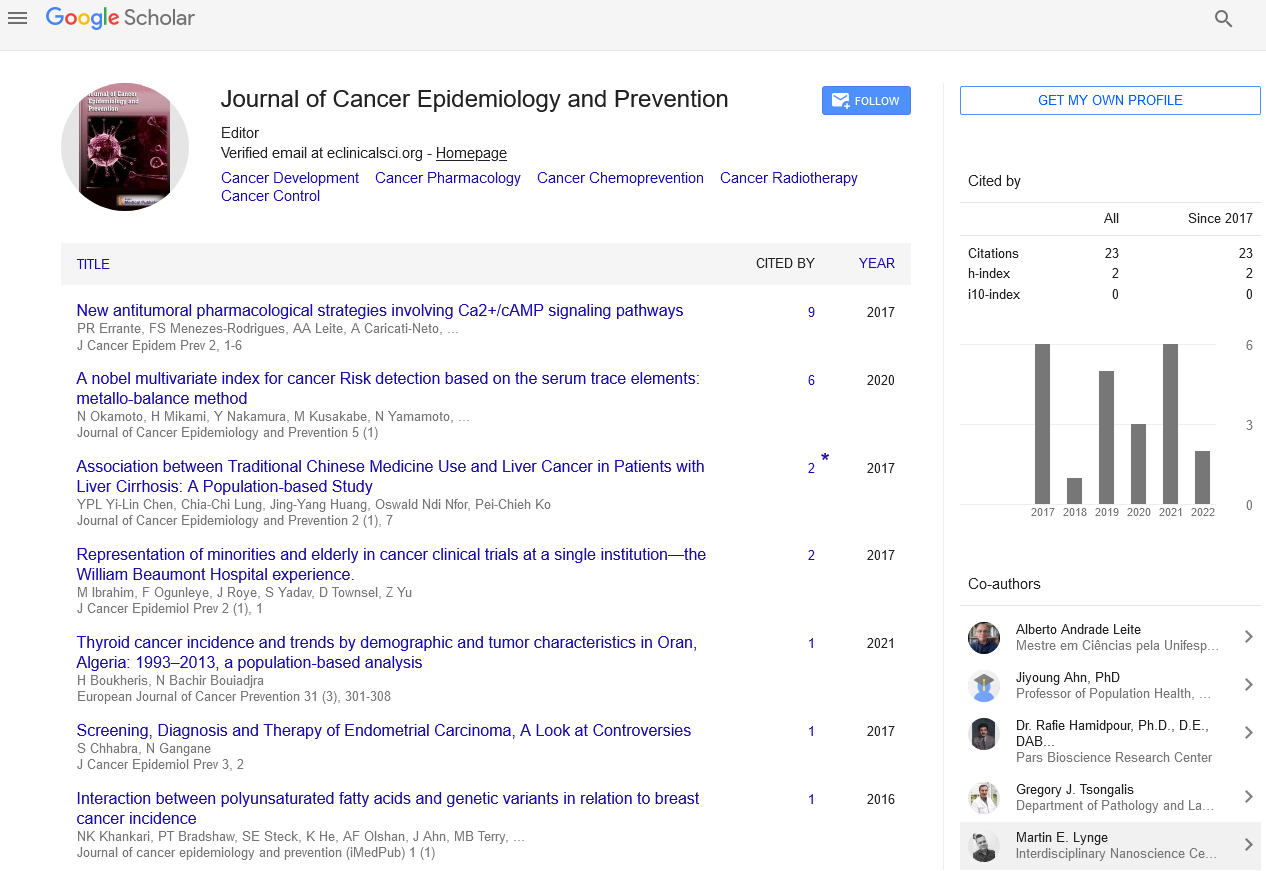Commentry - (2023) Volume 8, Issue 1
Paediatric Patients with Malignant Growth Inclination Conditions with their Disease
Kai Yang*
Department of Radio Oncology, University of Valencia, Spain
*Correspondence:
Kai Yang,
Department of Radio Oncology, University of Valencia,
Spain,
Email:
Received: 31-Jan-2023, Manuscript No. IPJCEP-23-15867;
Editor assigned: 02-Feb-2023, Pre QC No. IPJCEP-23-15867 (PQ);
Reviewed: 16-Feb-2023, QC No. IPJCEP-23-15867;
Revised: 21-Feb-2023, Manuscript No. IPJCEP-23-15867 (Q);
Published:
28-Feb-2023, DOI: 10.36648/IPJCEP.23.08.001
Description
When screening for prostate cancer, the PSA test can detect
small cancers that normally aren’t life-threatening but can be
treated once found. In this scenario, known as over diagnosis,
men are more likely to experience issues as a result of unnecessary
treatments like surgery or radiation. As side effects, follow-
up procedures for prostate cancer may cause infections
and bleeding. Prostate cancer treatment may result in erectile
dysfunction and incontinence. “While everyone wants to help
prevent deaths from prostate cancer, current methods of PSA
screening and treatment of screen detected cancer is not the
answer,” the United States Preventive Services Task Force concluded
in a 2012 recommendation against prostate-specific
antigen-based screening for prostate cancer. In North America,
the majority of medical associations recommended making
individual screening decisions based on the risks, benefits, and
preferences of the patient as of 2013. Similar to this, Fenton’s
2018 review of the two highest-quality randomized control
studies of the costs and benefits of PSA screening reveals the
intricate issues associated with cancer screening. Fenton says
that screening 1,000 men every four years for 13 years cuts
the death rate from prostate cancer by just one. In their recommendations
for 2018, the USPSTF estimates that between
20% and 50% of men who receive a positive PSA screening and
are diagnosed with prostate cancer has cancer that, if left untreated,
would never grow, spread, or cause harm. However,
the Scientific Advice Mechanism of the European Commission
recommended organized population-level organized prostate
cancer screening by 2022, concluding that new technologies,
particularly improved blood test screening, had altered the
balance of harms and benefits. During cancer immune-editing,
the immune system interacts with the cells of the tumor.
escape. During the elimination phase, the immune response
destroys the tumor cells to suppress the tumor. On the other
hand, there is a possibility that some tumor cells will acquire
additional mutations, alter their characteristics, and avoid being
detected by the immune system. These cells may enter a
state known as equilibrium, during which the immune system
will not recognize all of the tumor’s cells but the tumor will not
grow. The escape phase, during which the tumor takes control
of the immune system, begins to grow, and creates an immunosuppressive
environment, may result from this condition. Immuno-
editing causes tumor cell clones that are less responsive
to the immune system to gradually take over the tumor as the
known cells are destroyed over time. In Darwinian evolution,
pro-oncogenic or immunosuppressive mutations are passed on
to daughter cells, which may mutate and face additional selective
pressure. This could be compared to this. As a result, the
tumor is composed of cells that are difficult to eradicate and
less immunogenic. Immunotherapies administered to disease
patients were found to be the cause of this peculiarity. Syndromic
surveillance systems look for unusual patterns in data
from a variety of sources, such as hospital records of over-thecounter
drug sales, school absenteeism logs, emergency call
systems, and Internet searches. When they observe a spike in
activity in any of the systems that are being monitored, public
health professionals and disease epidemiologists are informed
that there may be a problem. A bioterrorist attack may be prevented
or slowed down in its progression, thereby saving many
lives, if it is detected and dealt with promptly. The most effective
syndromic surveillance systems automatically monitor
these systems in real time, do not require individuals to enter
separate information, have sophisticated analytical tools, aggregate
data from multiple systems across geopolitical boundaries, and have an automated alerting process. A syndromic
search query-based surveillance system was first proposed and
developed by Gunther Eysenbach in 2004. In 2008, Google sent
off Google Influenza Patterns because of these early, uplifting
encounters. An increase in flu activity is suggested by the rising
number of flu-related searches. The Nature-published results
were comparable to the CDC data and performed better by one
to two weeks. On the other hand, it has been demonstrated
that the initial strategy behind Google Flu Trends had a number
of modelling flaws, which led to significant estimation errors.
Based on Google search queries, a number of more advanced
linear and nonlinear strategies for influenza modelling have recently been proposed. As an extension of Google’s work,
researchers at the Intelligent Systems Laboratory created the
Flu Detector: An online tool that uses statistical analysis and
information retrieval to forecast flu rates in the UK uses Twitter
content.
Acknowledgement
None.
Conflict of Interest
The authors declare that they have no conflict of interest.
Citation: Yang K (2023) Paediatric Patients with Malignant Growth Inclination Conditions with their Disease. J Cancer Epidemiol Prev. 08:001.
Copyright: © 2023 Yang K. This is an open-access article distributed under the terms of the Creative Commons Attribution License, which permits unrestricted use, distribution, and reproduction in any medium, provided the original author and source are credited.

